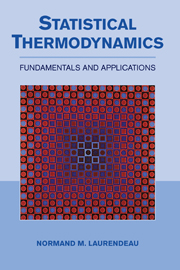Book contents
- Frontmatter
- Contents
- Preface
- 1 Introduction
- PART ONE FUNDAMENTALS OF STATISTICAL THERMODYNAMICS
- PART TWO QUANTUM MECHANICS AND SPECTROSCOPY
- PART THREE STATISTICAL THERMODYNAMICS IN THE DILUTE LIMIT
- PART FOUR STATISTICAL THERMODYNAMICS BEYOND THE DILUTE LIMIT
- PART FIVE NONEQUILIBRIUM STATISTICAL THERMODYNAMICS
- PART SIX THE ENSEMBLE METHOD OF STATISTICAL THERMODYNAMICS
- 18 The Canonical and Grand Canonical Ensembles
- 19 Applications of Ensemble Theory to Real Gases
- Problem Set VIII Ensemble Theory and the Nonideal Gas (Chapters 18–19)
- 20 Whence and Whither
- PART SEVEN APPENDICES
- Index
18 - The Canonical and Grand Canonical Ensembles
Published online by Cambridge University Press: 05 June 2012
- Frontmatter
- Contents
- Preface
- 1 Introduction
- PART ONE FUNDAMENTALS OF STATISTICAL THERMODYNAMICS
- PART TWO QUANTUM MECHANICS AND SPECTROSCOPY
- PART THREE STATISTICAL THERMODYNAMICS IN THE DILUTE LIMIT
- PART FOUR STATISTICAL THERMODYNAMICS BEYOND THE DILUTE LIMIT
- PART FIVE NONEQUILIBRIUM STATISTICAL THERMODYNAMICS
- PART SIX THE ENSEMBLE METHOD OF STATISTICAL THERMODYNAMICS
- 18 The Canonical and Grand Canonical Ensembles
- 19 Applications of Ensemble Theory to Real Gases
- Problem Set VIII Ensemble Theory and the Nonideal Gas (Chapters 18–19)
- 20 Whence and Whither
- PART SEVEN APPENDICES
- Index
Summary
To this point, we have dealt exclusively with systems composed of independent particles and thus we have utilized the Maxwell–Boltzmann method of statistical thermodynamics. We know, however, that at a sufficiently high pressure or low temperature any gas will begin demonstrating nonideal behavior. For such real gases, and also for liquids, centralized forces arise among constituent particles owing to shorter intermolecular distances. Consequently, we are eventually confronted with systems composed of dependent rather than independent particles. Such systems mandate that we forsake the Maxwell–Boltzmann method and turn instead to a more robust computational procedure known as the Gibbs or ensemble method of statistical thermodynamics.
The Ensemble Method
We recall from Section 3.2 that an ensemble is a mental collection of a huge number of identical systems, each of which replicates macroscopically the thermodynamic system under investigation. Because such replication occurs at the macroscopic and not at the microscopic level, every member of the ensemble may be associated with a possibly different system quantum state. In essence, the independent particles required for the Maxwell–Boltzmann method are replaced with independent systems for the ensemble method. As a result, when using the latter, we inherently retain independent events proffered for statistical analyses, while accounting for the intermolecular forces needed to model real gases and liquids. In so doing, we shift our focus from a consideration of particle quantum states to a consideration of system quantum states.
As discussed previously, the utility of the Gibbs method rests on two fundamental postulates of statistical thermodynamics.
- Type
- Chapter
- Information
- Statistical ThermodynamicsFundamentals and Applications, pp. 339 - 358Publisher: Cambridge University PressPrint publication year: 2005



